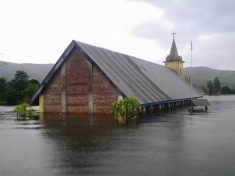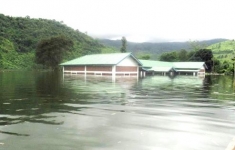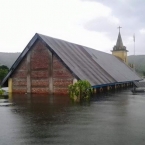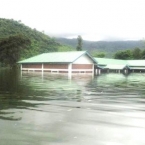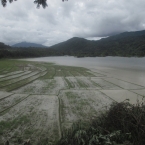Mapithel Dam: An Inside Look
Since January of this year, the Mapithel Dam has blocked the flow of the Thoubal River. As a result, the Mapithel valley in northeast India has changed drastically, in ways that are ruining the lives and aspirations of indigenous people inhabiting the area. Their only culpability is living in a serene valley blessed with majestic hills, virgin forests and an expanse of cultivable land. The villagers, accustomed to easygoing lives, could hardly imagine that a river that once nurtured their lives, and was so cherished by them, would unleash such misery and trauma.
Chadong is one of the worst-affected villages. Wooden planks, household items, furniture and other remnants of dismantled homes belonging to people who refused to give up their land are strewn along the village roads in the hills. The village community hall, houses, church and school buildings have been consumed by the rising dam reservoir one after another. A bridge and hill roads that once connected villages along the valley are now submerged under water. People have no choice but to rely on bamboo rafts and wooden canoes, taking hours to cross short distances. The desecration of religious sites, and the inundation of cemeteries where their ancestors lay buried, are salt to their wounds.
“Summer is when rain comes, when we till our land, plant our crops, and prepare the next harvest for our survival. In our tradition, we don’t leave our land during the rainy season,” exclaimed a resident of Chadong village, who added, “Mapithel dam today represents the symbol of injustice in Manipur.” A few days back, an elderly woman in Thoyee village visited her village church, located in higher elevations, and watched with a heavy heart watches as her land vanished under water. She still believed that the Manipur State authorities would visit and prevent the unfolding debacle in her village.
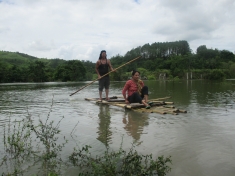
With their lost homes, forest and agricultural land, hope fades away that perhaps the state will consider their plight and heed long-standing calls for a democratic process respectful of their rights and needs for survival. For indigenous communities, land, forest and water provide their sustenance; losing these three things often results in disillusionment and hardships.
The Irrigation and Flood Control Department of the Government of Manipur commenced filing the Mapithel Dam reservoir in January 2015 in a forceful attempt to commission the Mapithel Dam of the Thoubal Multipurpose Hydroelectric Project. Due to early onset of the monsoon this year, the reservoir rose rapidly, submerging close to 2,000 hectares of forest, agricultural land, grazing ground and homesteads in the villages of Chadong, Riha, Ramrei, Thoyee, Senkai and Sikibung. By the end of July, many villagers living downstream from the Mapithel Dam fled to seek refuge in safer grounds as water leaked from the dam. The filling up of the reservoir even before the freshly-filled earth in the diversion channel had fully settled led to leaks and early erosion in the dam.
In addition to dam safety concerns, the filling of the reservoir led the Thoubal River to dry up immediately downstream. The villagers can no longer fish and collect sand stone brought down by the Thoubal River, an activity that had been their main economic mainstay. The ongoing process is accompanied with deployment of Indian security forces in affected villages to subdue all community resistance.
The National Green Tribunal is still considering the dam’s violation of forest rights under the Forest Conservation Act, 1980 and the Forest Rights Act, 2006. In clear procedural violations, the Ministry of Environment and Forest of the Government of India accorded final “Forest Clearance” for the dam only on 31st December 2013, more than 30 years after the project obtained approval in 1980. On August 4, 2015 the Tribunal asked a regional office of the environment ministry to file an affidavit on whether forestland was diverted prior to the completion of conditions stipulated in the clearance order. The officer “shall also answer on the point whether any forest land has been sub-merged for construction of the project and if so, from which date and its present status.” The affidavit has to be submitted by August 24 and then next hearing is has been fixed for the 26th. The State’s claim of land and forest purchase is a violation of the Manipur Hill Areas Regulation Act, 1956 and the Forest Rights Act, 2006; it also violates the UN Declaration on the Rights of Indigenous Peoples, 2007.
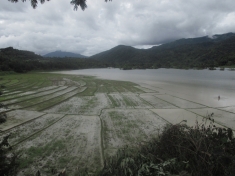
The big question is: who will benefit from the dam? Will the affected communities – the Tangkhul Naga in upstream areas, the Kuki people near the dam site, and the Meitei community downstream – ever benefit from this controversial dam? Thus far, they have only received incomplete compensation that the State offered without a detailed and participatory impact assessment procedure. We can only wonder whether the Mapithel dam will generate the intended power, irrigate agriculture land as promised, and supply drinking water to the state capital as targeted.
We believe that the waters of Mapithel Dam should be released gradually during the winter, and that the Thoubal River should flow free so the affected communities can resume their way of life, which traditionally depended on the river, forest and agricultural land for their survival.
Jitin Yumnam is Secretary, Centre for Research and Advocacy (Manipur), and can be contacted at: jitnyumnam@yahoo.co.in or mangangmacha@gmail.com

